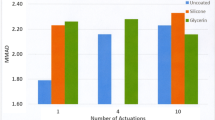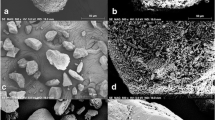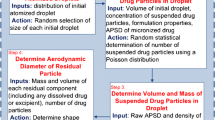ABSTRACT
The impact of formulation variables on aerodynamic and electrostatic properties of dry powder aerosol particles is of great importance to the development of efficient and reproducible inhaler products. Systematic evaluation requires a well-designed series of experiments using appropriate methods. A factorial experimental design was employed. In broad terms, the conditions considered were two drugs, albuterol and budesonide, in combination with different excipients, drug concentrations, delivered doses, and metering system (capsule composition) and sampled under different flow conditions using standard entrainment tubes. Samples were collected in an electrical low-pressure impactor, to evaluate distribution of electrostatic properties, and an Andersen eight-stage nonviable cascade impactor, to estimate aerodynamic particle size distribution, concurrently. The deposition studies allowed calculation of approximate per particle charge levels for drug. The results showed very high particle charge levels, often in the 1,000–10,000 of elementary charges per particle range, orders of magnitude higher than charge levels predicted by the Boltzmann charge distribution. The charge levels are considerably higher than had previously been estimated (200e per particle).












Similar content being viewed by others
References
Keskinen J, Pietarinen K, Lehtimaki M. Electrical low-pressure impactor. J Aerosol Sci. 1992;23:353–60.
Lehmann U, Niemela V, Mohr M. New method for time-resolved diesel engine exhaust particle mass measurement. Environ Sci Technol. 2004;38:5704–11.
Maricq MM, Chase RE, Xu N, Podsiadlik DH. The effects of the catalytic converter and fuel sulfur level on motor vehicle particulate matter emissions: gasoline vehicles. Environ Sci Technol. 2002;36:276–82.
Sanders PG, Xu N, Dalka TM, Maricq MM. Airborne brake wear debris: size distributions, composition, and a comparison of dynamometer and vehicle tests. Environ Sci Technol. 2003;37:4060–9.
Holmen BA, Qu Y. Uncertainty in particle number modal analysis during transient operation of compressed natural gas, diesel, and trap-equipped diesel transit buses. Environ Sci Technol. 2004;38:2413–23.
Brouwer DH, Gijsbers JH, Lurvink MW. Personal exposure to ultrafine particles in the workplace: exploring sampling techniques and strategies. Ann Occup Hyg. 2004;48:439–53.
Ferge T, Maguhn J, Felber H, Zimmermann R. Particle collection efficiency and particle re-entrainment of an electrostatic precipitator in a sewage sludge incineration plant. Environ Sci Technol. 2004;38:1545–53.
Kwok PCL, Glower W, Chan H-K. Electrostatic charge characteristics of aerosols produced from metered dose inhalers. J Pharm Sci. 2005;94:2789–99.
Telko MJ, Kujanpaa J, Hickey AJ. Investigation of triboelectric charging in dry powder inhalers using electrical low pressure impactor (ELPI). Int J Pharm. 2007;336:352–60.
Marjamaki M, Keskinen J, Chen DR, Pui DYH. Performance evaluation of the electrical low-pressure impactor (ELPI). J Aerosol Sci. 2000;31:249–61.
Murtomaa M, Strengell S, Laine E, Bailey A. Measurement of electrostatic charge of an aerosol using a grid-probe. J Electrost. 2003;58:197–207.
Murtomaa M et al. Effect of particle morphology on the triboelectrification in dry powder inhalers. Int J Pharm. 2004;282:107–14.
General Chapter <601> Aerosols, nasal sprays, metered dose inhalers, and dry powder inhalers, USP34/NF29, United States Pharmacopeial Convention, Rockville, MD, 1 (2011) 218–239.
Physician’s Desk Reference, 66th (2012) Edition, PDR Network, Montvale, NJ, 2011.
Steckel H, Bolzen N. Alternative sugars as potential carriers for dry powder inhalations. Int J Pharm. 2004;270:297–306.
Ganderton D. The generation of respirable clouds from coarse powder aggregates. J Biopharm Sci. 1992;3:101–5.
Clark AR, Hollingworth AM. The relationship between powder inhaler resistance and peak inspiratory conditions in healthy-volunteers—implications for in-vitro testing. J Aerosol Med. 1993;6:99–110.
Louey MD, van Oort M, Hickey AJ. Standardized entrainment tubed for the evaluation of pharmaceutical dry powder dispersion. J Aerosol Sci. 2006;37:1520–31.
Xu Z, Mansour HM, Mulder T, McLean R, Langridge J, Hickey AJ. Dry powder aerosols generated by standardized entrainment tubes from drug blends with lactose monohydrate: 1. Albuterol sulfate and disodium cromoglycate. J Pharm Sci. 2010;99:3398–414. doi:10.1002/jps.22107.
Xu Z, Mansour HM, Mulder T, McLean R, Langridge J, Hickey AJ. Dry powder aerosols generated by standardized entrainment tubes from drug blends with lactose monohydrate: 2. Ipratropium bromide monohydrate and fluticasone propionate. J Pharm Sci. 2010;99:3415–29. doi:10.1002/jps.22100.
Mansour HM, Xu Z, Hickey AJ. Dry powder aerosols generated by standardized entrainment tubes from alternative sugar blends: 3. Trehalose dihydrate and D-mannitol carriers. J Pharm Sci. 2010;99:3430–41. doi:10.1002/jps.22101.
Xu Z, Mansour HM, Mulder T, McLean R, Langridge J, Hickey AJ. Heterogeneous particle deaggregation and its implication for therapeutic aerosol performance. J Pharm Sci. 2010;99:3442–61. doi:10.1002/jps.22057.
Xu Z, Mansour HM, Hickey AJ. Particle interactions in dry powder inhaler unit processes: a review. J Adhes Sci Technol Spec Issue Adhes Asp Pharma Sci. 2011;25:451–82.
Xu Z, Hickey AJ. A comparison of aerosol performance in standardized entrainment tubes vs dry powder inhaler devices. KONA Powder Part J. 2013;30:201–9.
Liu BY, Pui DY, Rubow KL, Szymanski WW. Electrostatic effects in aerosol sampling and filtration. Ann Occup Hyg. 1985;29:251–69.
Hinds WC. Aerosol technology: properties, behavior, and measurement of airborne particles. New York: Wiley; 1999.
Cartwright S, Singh S, Bailey AG, Rose LJ. Electrostatic charging characteristics of polyethylene powder during pneumatic conveying. IEEE Trans Ind Appl. 1985;21:541–6.
Zhao H, Castle GSP, Inculet II. The measurement of bipolar charge in poly-disperse powders using a vertical array of faraday pail sensors. J Electrost. 2002;55:261–78.
Zhao H, Castle GSP, Inculet II, Bailey AG. Bipolar charging of poly-disperse polymer powders in fluidized beds. IEEE Trans Ind Appl. 2003;39:612–8.
Lacks DJ, Levandovsky A. Effect of particle size distribution on the polarity of triboelectric charging in granular insulator systems. J Electrost. 2007;65:107–12.
Duff N, Lacks DJ. Particle dynamics simulations of triboelectric charging in granular insulator systems. J Electrost. 2008;66:51–7.
Bailey AG, Hashish AH, Williams TJ. Drug delivery by inhalation of charged particles. J Electrost. 1998;44:3–10.
Fraser DA. The deposition of unipolar charged particles in the lungs of animals. Arch Environ Health. 1966;13:152–7.
Byron PB, Peart J, Staniforth JN. Aerosol electrostatics I: properties of fine powders before and after aerosolization by dry powder inhalers. Pharm Res. 1997;14:698–705.
Acknowledgments
Dr. Chris Wiesen, Statistical Consultant at the UNC Odum Institute, is gratefully acknowledged for valuable discussions of the experimental design and help with the analysis. M. Telko gratefully acknowledges the financial support from a U.S. Pharmacopeia Fellowship and PhRMA Foundation Predoctoral fellowship during the completion of this work.
Author information
Authors and Affiliations
Corresponding author
Additional information
Guest Editors: Paul B. Myrdal and Steve W. Stein
Rights and permissions
About this article
Cite this article
Telko, M.J., Hickey, A.J. Aerodynamic and Electrostatic Properties of Model Dry Powder Aerosols: a Comprehensive Study of Formulation Factors. AAPS PharmSciTech 15, 1378–1397 (2014). https://doi.org/10.1208/s12249-014-0144-5
Received:
Accepted:
Published:
Issue Date:
DOI: https://doi.org/10.1208/s12249-014-0144-5




